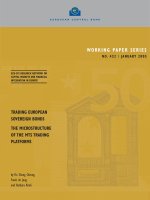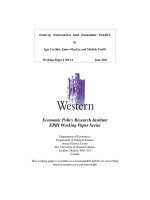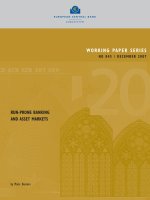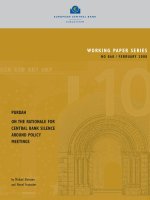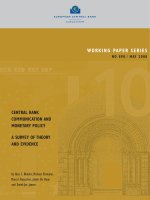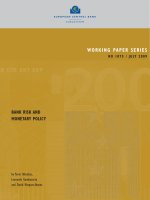Working paper series the phillips curve and long-term unemployment
Bạn đang xem bản rút gọn của tài liệu. Xem và tải ngay bản đầy đủ của tài liệu tại đây (895.63 KB, 49 trang )
W ORKING PAPER SERIES
NO. 441 / FEBRUARY 2005
THE PHILLIPS CURVE
AND LONG-TERM
UNEMPLOYMENT
by Ricardo Llaudes
In 2005 all ECB
publications
will feature
a motif taken
from the
€50 banknote.
W ORKING PAPER SERIES
NO. 441 / FEBRUARY 2005
This paper can be downloaded without charge from
or from the Social Science Research Network
electronic library at />THE PHILLIPS CURVE
AND LONG-TERM
UNEMPLOYMENT
1
by Ricardo Llaudes
2
1 I am grateful to Laurence Ball,Thomas Lubik, Christopher Carroll, Benoit Mojon,Adrian Pagan, an anonymous referee,
and seminar participants at the European Central Bank and Johns Hopkins University for many helpful
comments and suggestions.
2 The Johns Hopkins University, Department of Economics, 3400 N. Charles Street, Baltimore, MD 21218, USA;
e-mail:
© European Central Bank, 2005
Address
Kaiserstrasse 29
60311 Frankfurt am Main, Germany
Postal address
Postfach 16 03 19
60066 Frankfurt am Main, Germany
Telephone
+49 69 1344 0
Internet
Fax
+49 69 1344 6000
Telex
411 144 ecb d
All rights reserved.
Reproduction for educational and non-
commercial purposes is permitted provided
that the source is acknowledged.
The views expressed in this paper do not
necessarily reflect those of the European
Central Bank.
The statement of purpose for the ECB
Working Paper Series is available from
the ECB website, .
ISSN 1561-0810 (print)
ISSN 1725-2806 (online)
3
ECB
Working Paper Series No. 441
February 2005
CONTENTS
Abstract 4
Non-technical summary 5
1 Introduction 7
2 Evolution and studies of unemployment in
the OECD 9
2.1 Studies on long-term unemployment 11
3 Econometric model: the Phillips curve and
the NAIRU 12
3.1 Unemployment duration version of
the Phillips curve 13
3.2 Estimation issues 15
4 Empirical results 16
4.1 Main model results 16
4.2 Time path of the NAIRU 20
4.3 Confidence intervals 21
4.4 Euro area analysis 22
4.5 Implications for forecasting 24
4.5.1 Evaluating the forecasts 26
5 The role of labor market institutions 27
6 Robustness to alternative specifications 30
6.1 The wage Phillips curve 31
6.2 The effect of supply shocks 31
6.3 Changes to the signal-to-noise ratio 32
7 Conclusions 30
References 35
Tables and figures 39
European Central Bank working paper series 45
4
ECB
Working Paper Series No. 441
February 2005
Abstract
This paper studies the role of long-term unemployment in the determination of prices and wages.
Labor market theories such as insider-outsider models predict that this type of unemployed are
less relevant in the wage formation process than the newly unemployed. This paper looks for
evidence of this behavior in a set of OECD countries. For this purpose, I propose a new
specification of the Phillips Curve that contains different unemployment lengths in a time-varying
NAIRU setting. This is done by constructing an index of unemployment that assigns different
weights to the unemployed based on the length of their spell. The results show that
unemployment duration matters in the determination of prices and wages, and that a smaller
weight ought to be given to the long-term unemployed. This modified model has important
implications for the policy maker: It produces more accurate forecasts of inflation and more
precise estimates of the NAIRU.
Keywords: Long-term unemployment, Phillips curve, NAIRU, Kalman filter.
JEL classification: C22, E31, E50, J64
Non-technical summary
The emergence of long-term unemployment has shaped the unemployment experi-
ences of many developed (OECD) countries over the last two decades. Two key issues
concerning this type of unemployment are of particular research interest. First, longer
unemployment spells can be related to lower transition probabilities out of unemploy-
ment and into employment. Second, the long-term unemployed are less relevant to
wage and price formation than the newly unemployed. This paper investigates the im-
portance of the second of these issues for the short-run trade-off between inflation and
unemployment implied by the Phillips Curve and the NAIRU (the Non-Accelerating
Inflation Rate of Unemployment). This is a relevant question, given that the inverse
short-run relationship between prices and unemployment is widely used by policymak-
ing institutions to assess the desired stance of monetary policy. Yet in the presence of
long-term unemployment, the aggregate rate of unemployment may provide a distorted
measure of the true demand pressures exerted on prices and wages. This argument
rests on the assumption that the long-term unemployed play a marginal role in the
wage formation process. In this paper, I investigate whether evidence of this behavior
ispresentinasetof19OECDcountries. Itisthefirst paper that undertakes such a
systematic, multi-country study. The analysis uses a modified version of an otherwise
standard Phillips Curve model that allows for different unemployment lengths to enter
the estimation. This is done by constructing an index of unemployment that assigns
different weights to the unemployed based on the length of their unemployment spell.
This deviates from the standard practice of using the aggregate unemployment rate.
Optimal weights are determined by the estimation of the model by maximum likelihood
using the Kalman filter.
5
ECB
Working Paper Series No. 441
February 2005
The results obtained show that unemployment duration does matter in the determi-
nation of prices and wages as concluded by the Phillips Curve estimations, and that a
smaller weight ought to be given to the long-term unemployed, confirming theoretical
arguments presented in the paper. Moreover, the impact of the long-term unem-
ployed is not found to be uniform across countries. In some countries, in particular
some Western European countries, the long-term unemployed have a negligible effect
on prices. This variation across countries can be explained by some of the institu-
tions that characterize labor markets in the OECD, such as employment protection
and unionization levels. Insofar as the monetary authority employs Phillips Curve
models and the corresponding NAIRUs derived to asses inflationary pressures and to
forecast inflation, the results in this paper are relevant to the policy maker. That is,
by looking at a break down of unemployment in terms of duration, the policy maker
receives more accurate information concerning inflationary developments. This paper
finds that this improved measure produces more accurate forecasts of inflation at both,
the one-year and two-year horizons. There are also implications for the estimation of
the NAIRU. The modified model of the Phillips Curve generates more precise esti-
mates of the NAIRU, with an average reduction in the mean width of the confidence
bands of close to 20 percent.
6
ECB
Working Paper Series No. 441
February 2005
1Introduction
Over the last two decades, one of the most important labor market phenomena in many devel-
oped countries has been the emergence and persistence of long-term unemployment.
1
Starting
in the early 1980s, the number of long-term unemployed in many OECD countries soared in
relation to the already growing number of unemployed.
2
As a result, considerable research
has been devoted to study issues such as the process leading to long-term unemployment, its
effects, and possible solutions.
3
The objective of this paper is to study the implications of long-term unemployment in the
determination of prices and wages. This is an important issue because the inverse short-run
relationship between prices and unemployment, as captured by the Phillips Curve and the
NAIRU (the Non-Accelerating Inflation Rate of Unemployment), is widely used by policy-
making institutions to assess the desired stance of monetary policy and to forecast inflation
(Boone et al, 2002). However, in the presence of long-term unemployment, the aggregate rate
of unemployment may provide a distorted measure of the true demand pressures exerted on
prices and wages. On this subject, the OECD argues that when long-term unemployment is
high "...unemployment becomes a poor indicator of effective labor supply, and macroeconomic
adjustment mechanisms- such as downward pressure on wages and inflation when unemploy-
ment is high- will then not operate effectively..." (OECD, 2002, p.189). The argument rests
on the assumption that the long-term unemployed play an unimportant role in the setting of
prices and wages. This has a number of important implications for the policy maker: If the
long-term unemployed become less relevant to price formation, then the downward pressure
of unemployment on prices decreases and unemployment becomes more persistent (Blanchard
and Wolfers, 2000). Furthermore, if long-term unemployment is high, a given reduction in
inflation may require extra contractionary measures as the pool of long-term unemployed will
not contribute much to bringing inflation down.
In this paper I provide evidence of the role that unemployment duration plays in the
1
Following the preferred OECD terminology, I will define as long-term unemployed those individuals in the
labor force who have been out of work for one year or longer. Short-term unemployed will be those out of work
for less than one year.
2
The OECD (1983, 1987) mentions 1982 as a year with particularly sharp increases in long-term unemploy-
ment in several countries.
3
For a more comprehensive analysis of the trends, incidence and composition of long-term unemployment
see OECD (1983, 1987, 2002) and Layard et al (1991). Machin and Manning (1999) survey the literature on
long-term unemployment.
7
ECB
Working Paper Series No. 441
February 2005
determination of prices and wages using a set of nineteen OECD countries. This is the first
paper that undertakes such a systematic, multi-country study. In the spirit of Nickell (1987)
and Manning (1994), I propose a modified version of an otherwise standard Phillips Curve
model that allows for different unemployment lengths to enter the estimation. This is done
by constructing an index of unemployment that assigns different weights to the unemployed
based on the length of their unemployment spell. These weights are a measure of the impact
that the unemployed have on prices. This deviates from the standard practice of using the
aggregate unemployment rate.
4
Optimal weights are determined by the estimation of the
model by maximum likelihood using the Kalman filter. The use of the Kalman filter enables
the estimation of a time-varying NAIRU. This is an important point of departure from Nickell
(1987) and Manning (1994), who assume a constant NAIRU.
The results obtained show that unemployment duration does matter in the determination
of prices and wages, and that a smaller weight ought to be given to the long-term unemployed.
The results also show that in those countries where long-term unemployment is high (namely,
some Western European countries), the long-term unemployed play little role in the setting
of prices and wages. This contrasts with non-European OECD countries, where all the un-
employed have similar impact, regardless of the length of their spell. These cross-country
variations can be explained by some of the institutions that characterize labor markets in the
OECD, such as union coverage levels and employment protection.
Insofar as the monetary authority employs Phillips Curve models and the NAIRU to asses
inflationary pressures and to forecast inflation, the results in this paper are relevant to the
policy maker. That is, by looking at a break down of unemployment in terms of duration, the
policy maker receives more accurate information concerning inflationary developments. As the
results will further show, this modified version of the Phillips Curve produces more accurate
forecasts of inflation at both the one-year and two-year horizons, and generates more precise
estimates of the NAIRU, with an average improvement of around 20 percent.
The paper is organized as follows. Section 2 reviews the evolution of unemployment in the
OECD and possible explanations. Section 3 presents the baseline and modified econometric
models and discusses a number of estimation issues. Section 4 lays out the main empirical
results of both models. Section 5 relates the results to a number of labor market institutions.
Section 6 checks for robustness of the results. Section 7 concludes.
4
The standard unemployment rate gives equal weight to all the unemployed, regardless of the length of their
spell
8
ECB
Working Paper Series No. 441
February 2005
2 Evolution and Studies of Unemployment in the OECD
The unemployment experience in the OECD countries over the last two decades shows re-
markable contrasts, with large disparities in its evolution across member countries. While
countries outside Europe have been able to maintain relatively low and stable levels of un-
employment, Western European countries have, for the most part,
5
suffered from persistently
high and fairly volatile levels of unemployment. However, this has not always been the case.
The upper panel of Figure 1 shows the unemployment rates for three different groups of coun-
tries: OECD Europe, OECD non-Europe, and OECD non-Europe excluding the US. For the
greater part of the 1970s unemployment in Europe remained at low levels, comparable to those
in other countries (and lower than in the US). Only at the end of the 1970s and early 80s, after
the second oil shock and the subsequent disinflationary policies, did unemployment in Europe
start to sharply rise in relation to the non-European countries. It quickly jumped from a rate
of 2.9 percent in 1974 to a peak of nearly 10.5 percent in 1985. It remained at high levels
for the rest of the decade. On the other hand, growth in unemployment outside Europe was
much less pronounced, it reversed trend earlier, and by the end of the 1990s it was back to its
pre-shock levels. The global slowdown of the early 1990s also had some important and inter-
esting implications for unemployment: While it caused another big increase in unemployment
in Europe, it was short-lived and relatively painless outside.
A large number of studies have attempted to explain these differences in the behavior of
unemployment (see Nickell, 1997; Siebert, 1997; Blanchard and Wolfers, 2000; Ljungqvist and
Sargent, 1998). These studies argue that the emergence of long-term unemployment provides
an insight into the unemployment experiences in many OECD countries from the early 80s into
90s.
6
The middle panel of Figure 1 depicts short-term unemployment rates while the lower
panel shows long-term unemployment rates. It is easy to see that most of the unemployment
growth in Europe can be attributed to the striking growth in long-term unemployment. Its
rate quickly jumped from about 1 percent in 1976 to almost 6 percent in 1985, remaining at
high levels ever since.
7
On the other hand the behavior of short-term unemployment was
5
Even within the group of European nations, the behavior of unemployment has displayed very little ho-
mogeneity across countries. Nickell (1997) warns against this lumping but claims that it is convenient for
analytical purposes.
6
This is related to the concept of hysteresis introduced by Blanchard and Summers (1986): The existence of
long-term unemployed will result in unemployment becoming more persistent. This deviation of unemployment
from its equilibrium value will cause the equilibrium value itself to change over time.
7
The problem of long-term unemployment continues to this day. The OECD (2002) reports that in 2000,
over 50% of the unemployed in Italy, Greece, Belgium, Ireland, and Germany were long-term unemployed.
9
ECB
Working Paper Series No. 441
February 2005
Figure 1: The Evolution of Unemployment in the OECD
1970
1975
1980
1985
1990
1995
2000
2
4
6
8
10
12
14
Unemployment Rates in the OECD
1970
1975
1980
1985
1990
1995
2000
2
4
6
8
10
12
14
Short-Term Unemployment Rate (1-12 months)
1970
1975
1980
1985
1990
1995
2000
2
4
6
8
10
12
14
Long-Term Unemployment Rate (12 months and over)
Source: OECD
OECD Europe
OECD Non-Europe
OECD Non-Europe Ex. US
OECD Europe
OECD Non-Europe
OECD Non-Europe Ex. US
OECD Europe
OECD Non-Europe
OECD Non-Europe Ex. US
10
ECB
Working Paper Series No. 441
February 2005
similar to that in other countries; short-term unemployment in OECD Europe averaged 4.9
percent during the1980s and 1990s, versus 4.8 percent in non-European OECD countries (3.3
percent if excluding the US).
2.1 Studies on Long-Term Unemployment
The transition from unemployment to long-term unemployment has spawned an abundant
literature in labor economics seeking to provide microeconomic foundations to the problem.
One argument is that as the unemployment spell lengthens, workers lose some of their human
capital. An immediate consequence is that they become less employable. Theoretical studies
by Pissarides (1992) and Ljungqvist and Sargent (1998) use this loss of skills assumption to
explain why some individuals become long-term unemployed after a temporary negative shock
to unemployment. Similarly, after some time unemployed, individuals become discouraged
and diminish their job search intensity, lowering their probability of finding employment (see
Devine and Kiefer, 1991; Schmitt and Wadsworth, 1993). Another strand of the literature
focuses on the firm’s behavior in relation to the long-term unemployed. Blanchard and Dia-
mond (1994), Lockwood (1991), and Acemoglu (1995) conclude that firms prefer to hire newly
unemployed individuals over those individuals with longer unemployment spells. In a process
they call "ranking", Blanchard and Diamond (1994) assume that a firm receiving multiple job
applications always picks the applicant with the shortest unemployment spell. This implies
that the exit rate from unemployment becomes a negative function of duration
8
and the overall
state of the labor market.
A crucial implication of the literature presented above is that those individuals who have
been unemployed short-term will have the greatest impact on wage setting. On the wage
formation effects of long-term unemployment, Blanchard and Diamond (1994) point out that
"...one implication is that long-term unemployment, per se, has little effect on wages." The
argument is that wages depend on the labor market prospects of the employed or newly un-
employed, rather than on the prospects of the average unemployed. Efficiency wage models
(Akerlof and Yellen, 1986) give support to this idea: If firms prefer to hire the newly un-
employed because they are assumed to be more productive and less costly, the equilibrium or
"efficiency wage" is determined by the wage demands of this preferred group. The literature
8
Lockwood (1991), and Acemoglu (1995) arrive to a similar conclusion. They claim that firms use unem-
ployment duration as a signal of the individual’s productivity level on which to base their hiring decisions.
11
ECB
Working Paper Series No. 441
February 2005
on insider-outsider models
9
arrives at similar conclusions: The long-term unemployed, as out-
siders,havelittleinfluence on the wage bargaining process, while the insiders, the employed
or newly unemployed, have the ability to impose their wage aspirations.
While most of the micro literature reviewed above takes a theoretical approach, there is
only a small number of empirical studies that look for evidence of the effects discussed, largely
for the UK. Studies by Nickell (1987) and Manning (1994) use UK data to claim that the
long-term unemployed fail to exert downward pressure on earnings, or equivalently, that there
is no significant association between this type of unemployment and wages (Manning, 1994).
Franz (1987) arrives at similar conclusions using data for West Germany. Nevertheless, the
results in these studies are not very conclusive (Blanchflower and Oswald, 1984) and should
be interpreted with caution because of two important shortcomings: They concentrate on one
country for a small time period, and they do not allow for a time-varying NAIRU. Both of
these shortcomings are addressed in this paper.
Similarly, a number of studies use microdata to assess the impact of local unemployment
on individual wages (see Pekkarinen (2001) for Finland, Blackaby and Hunt (1992) for the UK,
and Winter-Ebmer (1996) for Austria). These studies find a positive relationship between
long-term unemployment and wages.
3 Econometric Model: The Phillips Curve and the NAIRU
The short-run trade-off between inflation and unemployment has become one of the most
important tools in the design and implementation of monetary policy (Gordon, 1997). Closely
associated with this trade-off is the concept of the NAIRU, or that level of unemployment
consistent with stable inflation.
The NAIRU can be inferred from an expectations-augmented Phillips Curve of the following
general form
10
:
π
t
− π
e
t
= β (L)
¡
π
t−1
− π
e
t−1
¢
+ γ (L)
¡
u
t−1
− u
N
t−1
¢
+ δ (L) X
t
+ ε
t
(1)
where π
t
and π
e
t
denote realized and expected inflation, β (L), γ (L),andδ (L) are polynomials
in the lag operator, u
N
t
is the NAIRU at time t,andX
t
is a vector of possible supply shocks
9
Lindbeck and Snower (1989) survey the literature on insider-outsider theories.
10
Staiger et all (1997, 2001), Greenslade et all (2003), and Fabiani and Mestre (2001) are a few of the numerous
studies on the Phillips Curve and the NAIRU.
12
ECB
Working Paper Series No. 441
February 2005
(typically commodity prices or import prices). The disturbance ε
t
is assumed to be i.i.d.
normal with mean zero and variance σ
2
ε
. ε accounts for supply shocks that shift the inflation-
unemployment trade-off, such as import prices or changes in the exchange rate.
11
There are two key issues concerning the estimation of equation (1). The first one is the
specification of the inflation expectations. The second one is the modelling of the unobserved
NAIRU. In relation to the former, it has become practice in much of the literature (see
Staiger et all (1997)) to assume that expectations follow a random walk, that is, π
e
t
= π
t−1
,
so π
t
− π
e
t
= ∆π
t
. In regards to the modelling of the NAIRU, it is now widely accepted that
it varies over time
12
(see King and Watson (1994), Steiger et all (2001), Gordon (1997)). On
this subject, most of the recent literature assumes that the NAIRU follows a random walk,
and equation (1) is augmented with the following process for the NAIRU:
u
N
t
= u
N
t−1
+ ν
t
(2)
where ν
t
is assumed to be i.i.d. normal with mean zero and variance σ
2
ν
and uncorrelated with
ε
t
at all leads and lags. The system formed by equations (1) and (2) can be expressed in its
state-space form and can be estimated by maximum likelihood using the Kalman filter. A key
advantage of the Kalman filter is that it can generate standard errors for the estimates of the
NAIRU.
3.1 Unemployment Duration Version of the Phillips Curve
This section introduces a modified version of the standard Phillips Curve model that accounts
for different lengths in the duration of unemployment
13
. As previously discussed, the standard
Phillips Curve uses the aggregate unemployment rate to measure economic activity and demand
pressures on inflation. However, this may not be the most accurate indicator of inflationary
pressures, given that all the unemployed are entered with equal weights, regardless of the
length of their spell. As an alternative, this paper proposes an index of unemployment that
gives different weight to individuals based on the length of their unemployment spell. This
index would indeed become a truer measure of wage and price pressures. The index takes the
11
Section 6 on robustness will explicitly take into account the effect of supply shocks.
12
In many initial studies, especially for the US, the NAIRU was assumed to be constant.
13
The idea of modifying the Phillips Curve by including other measures of unemployment is not new. Duca
(1996) adds data on duration of unemployment, Roed (2002) uses job vacancy rates, and Ball and Moffitt (2001)
considers productivity growth.
13
ECB
Working Paper Series No. 441
February 2005
following form:
˜
U = αU
s
+(1− α) U
l
(3)
where α is the weight assigned to the short-term unemployed, U
s
is the short-term unemploy-
ment rate and U
l
is the long-term unemployment rate. The value of α will be determined by
the estimation. For the purpose of this paper, the duration version of the Phillips Curve will
now be expressed as:
∆π
t
= γ
³
˜
U
t
−
˜
U
N
t
´
+ ε
t
. (1’)
This specification of the Phillips Curve is similar to that used by Gordon (1997, 1998), Ball
and Mankiw (2002),the OECD (2000), and others in that it allows the contemporaneous unem-
ployment gap to enter as a regressor. This assumes that there is no contemporaneous feedback
from inflation to unemployment
14
. This specification also implies that inflation expectations
follow a random walk, so the model can be estimated in first differences of inflation.
This paper also modifies the standard Phillips Curve framework by modeling the NAIRU
as a random walk with an stochastic drift. This is done to better capture the movements in
unemployment observed in most European countries (Laubach, 2001, and Fabiani and Mestre,
2001). Accordingly, equation (2) is now replaced by
˜
U
N
t
=
˜
U
N
t−1
+ µ
t−1
+ ν
t
(2’)
where
µ
t
= µ
t−1
+ η
t
(4)
where η
t
is assumed i.i.d. normal
¡
0,σ
2
η
¢
, and uncorrelated with ε
t
and ν
t
. Equations (1’),
(2’), and (4) can be expressed in state-space form and estimated using the Kalman filter.
Note that the modified version of the Phillips Curve is parsimonious. It omits supply shock
variables or lag values of the unemployment index. This is mostly the result of data limitations.
Nevertheless, section 6 checks for robustness of the results to alternative specifications of the
model.
14
Appendix B in Gruen et all (1999) explains the exogeneity assumptions relevant to the estimation of Phillips
Curves.
14
ECB
Working Paper Series No. 441
February 2005
3.2 Estimation Issues
The system formed by equations (1’), (2’), and (4) can be estimated by maximum likelihood as
described in Harvey (1989) and Hamilton (1994, ch. 13). However, before proceeding with the
estimation of the parameters, a number of assumptions are required in terms of the behavior
of some of the variables and the treatment of some the parameters.
Modelling the NAIRU as a random walk with a drift implies that the NAIRU is an I(2)
process (given that the drift is I(1) itself). This paper will assume the unemployment gap
to be I(0), which implies that the change in inflationmustbeI(0)aswell. Table12in
the appendix shows results from augmented Dickey-Fuller unit root tests for ∆π. The table
contains the t-tests results for the null hypothesis that the data contains a unit root. Given
the corresponding critical values, the null hypothesis is soundly rejected for all the countries
in the sample except for Denmark (rejected at the 5% level). Therefore, the results confirm
that the change in inflation is I(0).
Before the Kalman filter algorithm can be started, the vector of parameters needs to be
initialized, including the state variable (the NAIRU). Initial values for the coefficient on the
unemployment gap are obtained from an OLS estimation of equation (1’)
15
. This procedure,
suggested by Hamilton (1994), is similar to the one employed by Fabiani and Mestre (2001).
The initial guess for the state variable will be the first observation of the HP-filtered unem-
ployment rate, that is,
˜
U
N
0
= U
hp
0
. It is important to note that the results obtained are robust
to the use of alternative starting values.
The final issue concerning the use of the Kalman filter deals with the smoothness of the
NAIRU. This is a problem akin to the selection of the smoothness parameter in the Hodrick-
Prescott filter (Gordon, 1997). The volatility of the NAIRU is determined by the signal-to-
noise ratio: σ
2
ν
/σ
2
ε
. The larger the ratio, the more volatile the NAIRU is, whereas a ratio
of zero implies a constant NAIRU. In principle, both components of the signal-to-noise ratio
can be estimated by the maximum likelihood procedure. However, as reported by Laubach
(2001), OECD (2000), and others, the estimation of the signal-to-noise ratio leads to very flat
NAIRUs
16
. In this paper, I will follow the approach of Steiger et all (1997), Laubach (2001),
and others, and will fix the signal-to-noise ratio at values in line with the existing literature.
15
The OLS estimation is done using the standard unemployment rate and its HP-filtered values. The use of
the unemployment rate assumes that the initial value of α is .5.
16
This is related to so-called pile-up problem: The ML estimate of the variance of a nonstationay state
variable with small true variance, such as the NAIRU, is downward biased towards zero.
15
ECB
Working Paper Series No. 441
February 2005
An alternative procedure to estimate median-unbiased estimates of the signal-to-noise ratio
suggested by Stock and Watson (1998) was initially tested, but the results were not very
satisfactory
17
. For the same arguments just explained, I will also fixthevalueofσ
η
.
4 Empirical Results
This section presents the estimation results. For every country in the sample, I am estimating
a baseline Phillips curve model using two different specifications. The first one employs the
standard unemployment rate, while the second one employs the unemployment index previously
described. This facilitates the assessment of the performance of the modified model with
respect to the standard model. As discussed in the previous section, some assumptions are
needed in terms of the underlying parameters of the model. In particular, the values of the two
parameters affecting the time variation of the NAIRU (σ
2
ν
/σ
2
ε
for high frequency variations and
σ
η
for low frequency) need to be determined. As in Laubach (2001), I will fix σ
2
ν
/σ
2
ε
and σ
η
at the same value for every country. I tested alternative values for both parameters based on
the range of values obtained when I let the parameters be freely determined by the estimation.
The values chosen were σ
η
=0.02 and σ
2
ν
/σ
2
ε
=0.04. These are relatively close to Laubach’s
0.015 and 0.049 respectively, and result in time profiles of the NAIRU that fall in line with
those in other studies (OECD, 2000).
4.1 Main Model Results
Results from estimating the Phillips Curve models for the countries in the sample are reported
in Table 1 and Table 2. Table 1 displays results for the European OECD countries whereas
Table 2 does it for the non-European countries. Each table contains results for both the
standard and the modified models. For each of the specifications, the coefficient on the
unemployment gap and standard errors are reported. Additionally, for the duration model,
the value of the estimated weight on short-term unemployment, α, and its standard error are
reported as well.
Focusing first on Table 1, columns three and four show that the γ coefficients on the
unemployment gap have the expected negative sign, and are quite precisely estimated. All the
coefficients are significant at the 10% level or better. This is consistent with results obtained
17
The estimation of the parameters in the signal-to-noise ratio led to very imprecise estimates, with a great
deal of variation across countries.
16
ECB
Working Paper Series No. 441
February 2005
Table 1. Estimation Results (OECD Europe)
Standard Modified LR
Country Sample UR LTU γγα
Belgium 1973-02 11.06 6.89 -0.643 -1.015 0.733 7.962
(0.124) (0.182) (0.060) 0.000
Denmark 1983-02 7.14 2.09 -0.268 -1.381 0.741 5.092
(0.112) (0.552) (0.065) 0.035
Finland 1978-02 8.40 2.23 -1.168 -0.743 0.804 12.449
(0.307) (0.148) (0.163) 0.000
France 1969-02 9.91 4.48 -0.232 -0.620 0.768 8.136
(0.051) (0.116) (0.108) 0.000
Germany 1973-02 7.10 3.18 -0.350 -0.592 0.630 9.471
(0.129) (0.173) (0.035) 0.000
Greece 1983-02 9.06 4.50 -0.739 -2.074 0.947 10.947
(0.321) (0.629) (0.134) 0.000
Ireland 1979-02 11.89 6.79 -0.225 -1.299 0.967 11.759
(0.087) (0.401) (0.043) 0.000
Italy 1979-02 10.40 6.55 -0.728 -1.922 0.860 14.390
(0.347) (0.801) (0.191) 0.000
Netherlands 1973-02 7.31 3.55 -0.518 -0.937 0.672 6.838
(0.096) (0.148) (0.028) 0.006
Norway 1979-02 3.76 0.54 -1.105 -1.633 0.729
4.993
(0.467) (0.671) (0.100) 0.038
Portugal 1986-02 5.58 2.64 -0.765 -1.728 0.881 9.275
(0.340) (0.683) (0.140) 0.000
Spain 1977-02 17.65 9.45 -0.243 -0.847 0.942 17.880
(0.053) (0.167) (0.013) 0.000
Sweden 1971-02 4.33 0.93 -0.475 -0.653 0.659 3.160
(0.079) (0.104) (0.084) 0.085
UK 1973-02 8.39 3.32 -1.045 -2.587 0.839 12.683
(0.342) (0.772) (0.183) 0.000
Average: 0.798
(0.084)
Note: White robust standard errors in parenthesis.
p values reported for LR test.
17
ECB
Working Paper Series No. 441
February 2005
Table 2. Estimation Results (OECD Non-Europe)
Standard Modified LR
Country Sample UR LTU γγα
Australia 1978-02 7.71 2.20 -0.749 -0.827 0.639 3.372
(0.312) (0.337) (0.221) 0.068
Canada 1976-02 9.12 1.28 -0.682 -1.268 0.556 3.609
(0.175) (0.318) (0.085) 0.053
Japan 1977-02 3.07 0.67 -1.612 -0.772 0.583 2.838
(0.715) (0.324) (0.127) 0.094
N. Zealand 1986-02 6.83 2.11 -0.899 -1.392 0.698 7.296
(0.381) (0.561) (0.168) 0.000
US 1968-02 6.21 0.54 -1.348 -2.161 0.538 3.074
(0.263) (0.403) (0.040) 0.089
Average: 0.603
(0.127)
Note: White robust standard errors in parenthesis.
p values reported for LR test.
by the OECD (2000) that find the contemporaneous unemployment gap to be quite indicative
of changes in inflation in all the OECD countries in their sample. Column five contains the
value of α, the weight on short-term unemployment. There is a good deal of cross-country
variation in the estimates. For countries like Spain, Portugal, Ireland, and Greece, the value of
α is around 0.9 or higher. This implies that the short-term unemployed alone have most of the
ability to affect prices. In other countries such as Holland, Germany, and Sweden, this ability
is more evenly distributed between both groups of unemployed (α values closer to 0.5). These
results are consistent with the argument that the long-term unemployed have a diminished
ability to influence prices. The precision with which these coefficients are estimated also
varies. In some cases. they are estimated quite precisely, while in others (Finland, Portugal,
and the UK), there is greater uncertainty around the estimate.
The standard model is equivalent to the modified model when α =0.5 (they are nested).
Given two nested models, the likelihood ratio test can be used to compare the two models
correcting for the number of restrictions. The last column in Table 1 reports the likelihood
ratio for the hypothesis that α =0.5. Given the number of restrictions, the test statistic
18
ECB
Working Paper Series No. 441
February 2005

